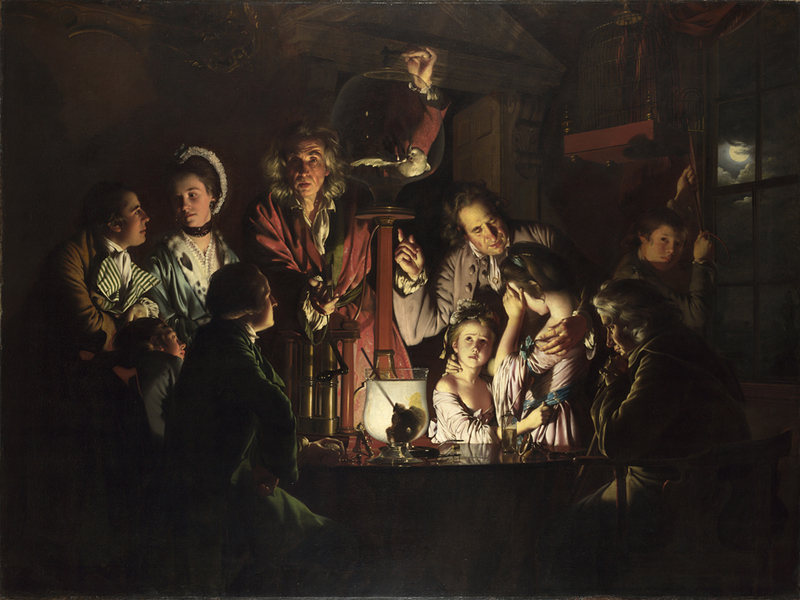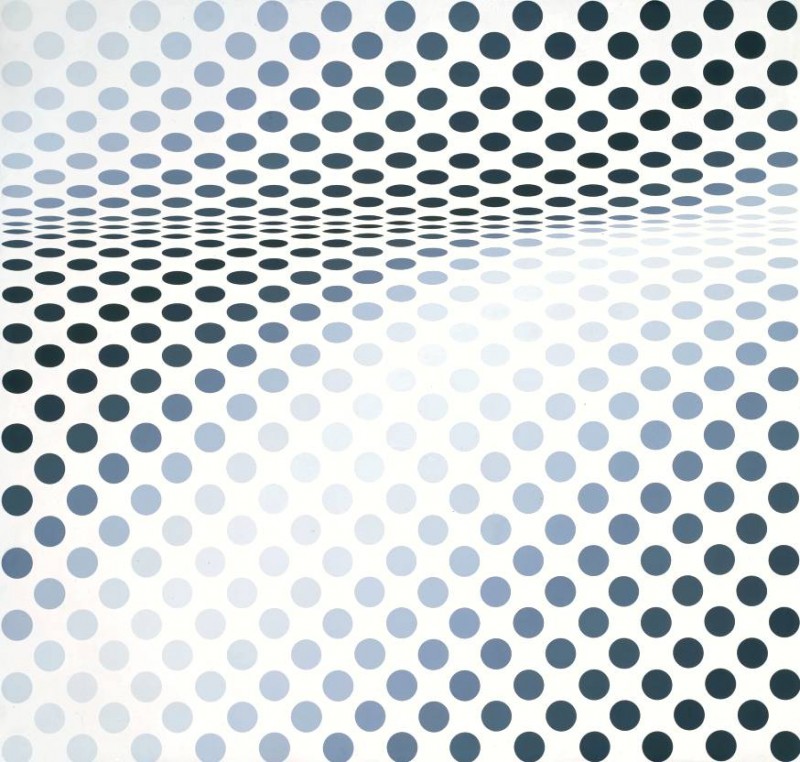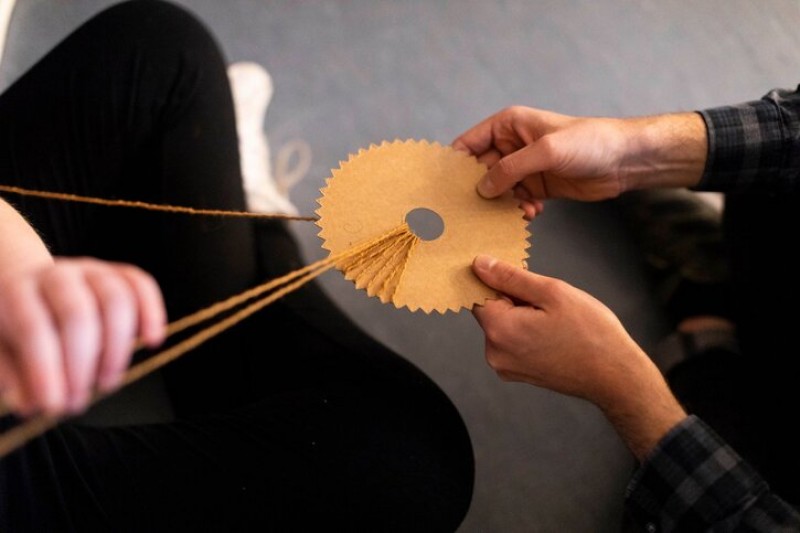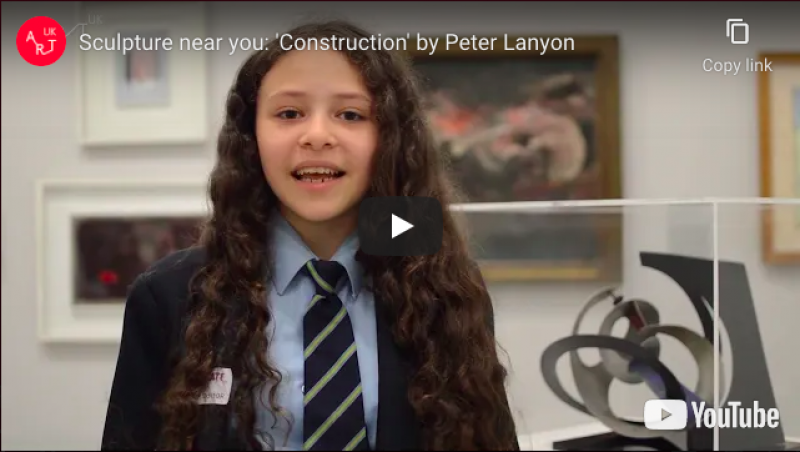'An Experiment on a Bird in the Air Pump' by Joseph Wright of Derby
This audio clip describes the painting An Experiment on a Bird in the Air Pump by Joseph Wright of Derby (1734–1797)
It has been created for use as part of our primary school resource, The Superpower of Looking, in order to support pupils with blindness or visual impairment to take part in the lessons.
Explore the painting further in our resource, An experiment by candlelight.
An Experiment on a Bird in the Air Pump
1768
Joseph Wright of Derby (1734–1797)
Full audio description text
This is a big picture, nearly two metres high – as tall as an adult might be – and nearly two and a half metres wide. It is painted in coloured oil paints by the artist Joseph Wright of Derby. He painted the picture in 1768, about 250 years ago.
The picture is filled with ten white people, men, women and children, closely gathered around a polished table in the centre of the picture where an experiment is taking place. It is nighttime, and the only light is from a candle on the table and the moon outside the window on the right of the picture. The walls of the room are in shadow, although an open door is visible behind the table.
On the table is a big glass jar of cloudy liquid, which glows from the lit candle behind it. A dark, knobbly shape floats in the liquid – it looks a little bit like a skull. The light from the candle illuminates the faces of the people around the table, their eyes glimmering in the soft light. They are all reacting in different ways to the experiment which is taking place.
A white bird called a cockatoo is inside a sealed glass jar, like a large bubble, which stands high above the table, on top of a thin wooden pedestal. A rubber tube runs from under the jar to small brass cylinders with a polished wooden handle attached. When the handle is turned, the air is sucked out of the jar. The cockatoo's beady eyes are open, as is its small, curved beak. The crest on the top of its head is standing upright, and one wing is stretched out awkwardly.
The scientist doing the experiment stands behind the bird in the jar, which is higher than his head. He has wild, shoulder-length grey hair, swept back from a wrinkled forehead, and thick dark eyebrows over bright enquiring eyes that seem to be looking straight at us. His lips are slightly parted, as if he might be speaking. He is wearing a red coat like a dressing gown, tied with a green belt, over a white shirt, the collar open at his neck. The scientist is reaching across the table with one hand as if inviting us in to watch the experiment.
On the other side of the table, opposite the scientist, at the front of the painting towards the left, sits a younger man in a green coat. His smooth-skinned face is turned away from us, showing only one of his cheeks, and his short hair is swept tidily back. This man is watching the bird with calm, but intent interest. He is holding a pocket watch, in one hand which rests on the table, as if he might be timing the experiment. Next to him to the left sits a boy, a teenager, leaning forward and peering up towards the bird.
Continuing around the table, standing between the teenager and the scientist, are a well-dressed young man and woman. He has a brown coat, the collar turned back to reveal a stripy grey and white lining. She wears ornate lace on her head, a fur-trimmed coat, and shiny black beads around her neck, with matching earrings. The man and woman have no interest in what is happening to the bird because they are gazing at each other.
To the right of the scientist is a group of three – a man, standing over two girls who wear pink dresses with elbow-length dangling sleeves, and scooped low necks. The man has one arm around the shoulders of the taller girl, a dark-haired teenager, who is covering her eyes with one hand. Her other hand is hugging a younger, shorter girl with blonde curls. This younger girl clings to the blue sash at the older girl's waist and looks up fearfully at the bird. But the man, perhaps their father, is pointing at the bird, as if to encourage them to watch.
Seated on the right of the table is a serious-looking gentleman in a grey coat. Stray locks of his thick, grey, wavy hair flop over his forehead, as he stares thoughtfully towards the candle – or he might be thinking about the mysterious object in the jar in front of it. It seems he has just taken off his wire-framed spectacles, which dangle from his fingers, hands clasped under his chin as he ponders.
The last onlooker, a boy, stands by the window to the right of the picture. He is holding a cord which runs up to a pulley on the ceiling, from which hangs a metal birdcage. It is unclear whether the boy is pulling it up out of the way, because it will no longer be required, or whether he is about to lower it down. His head is turned towards the table, and he watches the experiment with quiet curiosity. The scientist holds one hand above the top of the jar, his fingers on a valve which sticks up like a small tap. He can turn this valve to either keep the jar sealed, or open it to allow air to enter, deciding what will happen to the bird.




